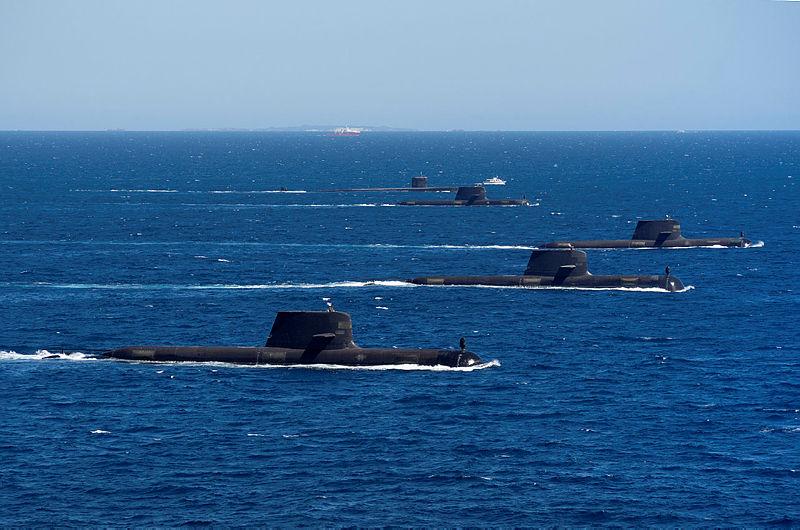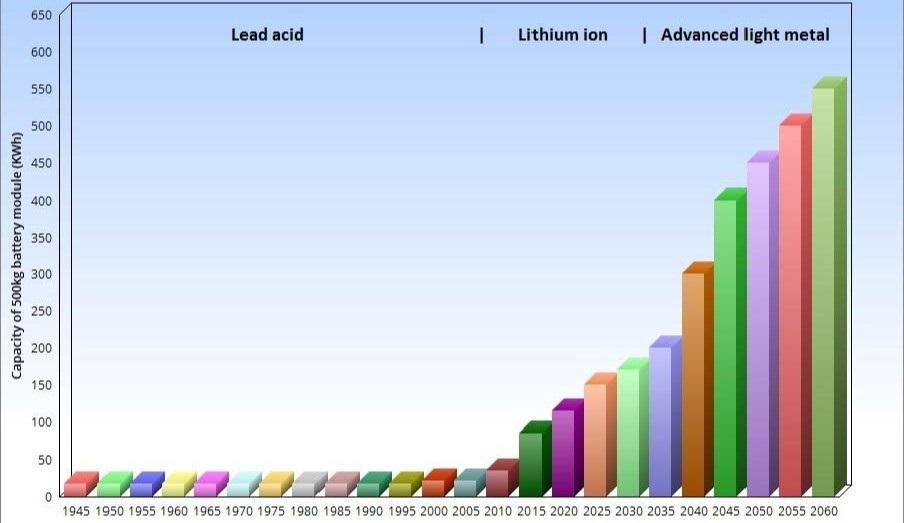Future-proofing the Attack class (part 2): performance and capacity
Posted By Derek Woolner and David Glynne Jones on July 4, 2019 @ 06:00

In part 1 [1], we discussed how we ensure we get the right propulsion system for Australia’s Attack-class submarines. We argued that nuclear power is an inadvisable and improbable option and observed that lithium-ion batteries, and other light-metal battery technology, could transform the nation’s submarine forces.
Here, we examine the extraordinary acceleration in the performance of light-metal batteries already being incorporated in submarines in our region. We argue that light-metal main batteries will dominate conventional submarine design and offer the promise of very significant improvements in performance.
It’s notable that the energy capacity of the lead–acid batteries used to power submarines for more than a century improved very little from the advanced German U-boats of World War II until the late 20th century.
The energy density of the batteries used in the navy’s six Collins-class submarines is similar to that of the batteries that powered Germany’s Type XXI Elektroboot in 1943.
And the output of the batteries aboard the navy’s previous class of submarines, the 1950s-era Oberons, was about 15% lower than those that powered the Type XXI.
There had been, in fact, surprisingly little improvement on the capacity of the batteries that powered submarines in World War I.
And despite the best efforts of manufacturers, lead–acid batteries today show an increase in energy output of only 10% over the batteries developed three decades ago for the Collins.
Submarine planners, builders and operators have long been aware of the potential advantages of lithium-ion main batteries for submarine propulsion. Peter Briggs provided an overview [2] in The Strategist in March 2016.
The advantages include improved endurance at both low and high speeds, no hydrogen emissions, higher charging rates, greater practical range, significant weight reduction for individual cells and less battery maintenance. The benefits are particularly pronounced when a submerged submarine is using its snorkel to run its diesel engines and charge its batteries.
Briggs also drew attention to the primary issue constraining early adoption of lithium-ion battery technology for submarine propulsion—the risk of battery fires. These may result from overcharging, inadequate battery management or an internal failure of a poorly manufactured battery cell.
In 2017, Defence Science and Technology established the Battery Safety Research Facility [3], specifically to address the issue of fire safety for lithium batteries in future Australian submarines. A significant body of work with direct relevance to the Attack-class program has also been undertaken by engineering consultants BMT Design & Technology. It’s now clear that submarine planners and builders in other countries are confident that requisite levels of operational safety can be achieved and sustained for lithium-ion batteries.
Since Briggs’ 2016 review, there have been significant developments in lithium-ion technology and its use in submarines. Mass-produced lithium-ion batteries have doubled in unit capacity and their cost has reduced by more than 40%.
Japan has launched the first large naval submarine with a lithium-ion main battery [4] and South Korea has undertaken a comprehensive 30-month technology readiness assessment [5] of the viability of lithium-ion technology for naval submarine main batteries. South Korea has also decided to build the second batch of its KSS-III attack submarines with lithium-ion main batteries, commencing in the early 2020s. Naval Group announced late last year that its LIBRT lithium-ion battery system [6] will be offered to Australia [7] for the second batch of Attack-class vessels.
The unit capacity of lithium-ion cells suitable for large-scale high-power applications has increased threefold since 2005. Further increases are expected in the early 2020s, and unit capacity could double again by the mid- to late 2020s. This would result in unit capacities around 10 to 12 times greater than current lead–acid battery technology.
As the practical capacity limits of lithium-ion cells are reached in the 2030s, the next generation of advanced light-metal cell technology will be emerging from the development and early production phases. The new light-metal cells will have theoretical capacities between three and five times greater than lithium-ion cells, and this could result in unit capacities 30–40 times greater than current lead–acid battery technology.
Submarine battery capacity: actual and projected, 1945–2060

Source: Based on published data and forecasts using established technology learning curves for light-metal battery technology.
The implications of the forecast rates of lithium-ion battery and advanced light-metal battery development and increased main battery capacity for naval submarine performance are profound.
By the mid-2030s, a large lithium-ion main battery could enable the construction of a ‘megabattery’ submarine able to patrol submerged, and without needing to recharge its battery, for 30 to 45 days. It could run submerged at high speed for several hours when required, with minor impact on endurance.
It’s conceivable that by the mid-2040s advanced light-metal battery technology could provide a submarine with a main battery of sufficient size to avoid the need for on-board charging.
Such a ‘gigabattery’ submarine could undertake a complete mission, including long-range transit, without the need to travel on or near the surface and with the capacity for many hours of high-speed submerged running. Running on electric power alone, it would be significantly stealthier than either conventional or nuclear submarines, with very low acoustic and thermal signatures.
Historically, most defence-related technologies have been too expensive to be widely adopted within Australian industry. Consequently, ADF equipment generally has been sourced from overseas or, if from within Australia, at a premium. The widespread adoption of advanced battery storage technologies will reverse that situation for a wide range of military propulsion systems.
Australia has significant lithium reserves and 90% of all the materials required to manufacture lithium-ion batteries. The government and opposition [8] are now actively endorsing and encouraging the development of a vertically integrated Australian lithium-ion battery industry. A $135-million industry-backed research hub [9] called the Future Battery Industries Cooperative Research Centre has been established in Western Australia.
Australia also has significant reserves of other materials expected to be utilised in future advanced light-metal batteries, including aluminium, magnesium, sulphur, graphite and silica.
It has the capacity to establish a sovereign light-metal battery capability within a decade or so, and to be in a position to manufacture and sustain light-metal submarine batteries for the foreseeable future.
Article printed from The Strategist: https://aspistrategist.ru
URL to article: /future-proofing-the-attack-class-part-2-performance-and-capacity/
URLs in this post:
[1] part 1: /future-proofing-the-attack-class-part-1-propulsion-and-endurance/
[2] overview: /sea1000-the-importance-of-dived-endurance-part-1/
[3] Battery Safety Research Facility: https://www.dst.defence.gov.au/news/2017/09/05/powering-future-submarine-fleets
[4] lithium-ion main battery: https://thediplomat.com/2018/10/japan-launches-first-lithium-ion-equipped-soryu-class-submarine/
[5] technology readiness assessment: https://www.globalsecurity.org/military/world/rok/kss-3-2.htm
[6] lithium-ion battery system: http://naval-group.com.au/2018/10/24/naval-group-presents-librt-its-new-generation-of-lithium-ion-batteries-system-for-submarines/
[7] offered to Australia: http://www.manmonthly.com.au/news/naval-group-presents-new-generation-lithium-ion-batteries-submarines/
[8] opposition: https://www.sbs.com.au/news/labor-eyes-local-lithium-battery-industry
[9] industry-backed research hub: https://news.curtin.edu.au/media-releases/wa-home-to-135-million-national-battery-research-hub/
Click here to print.